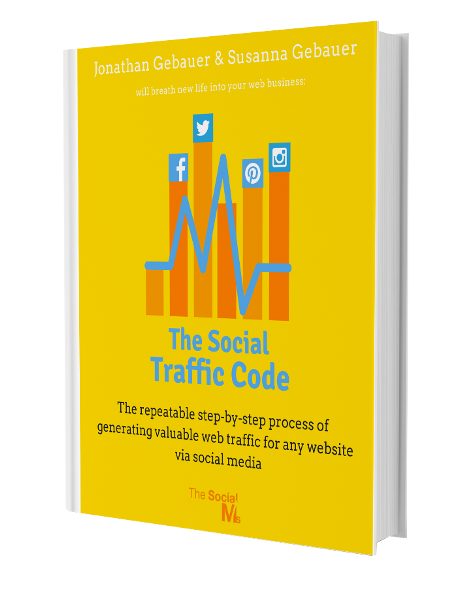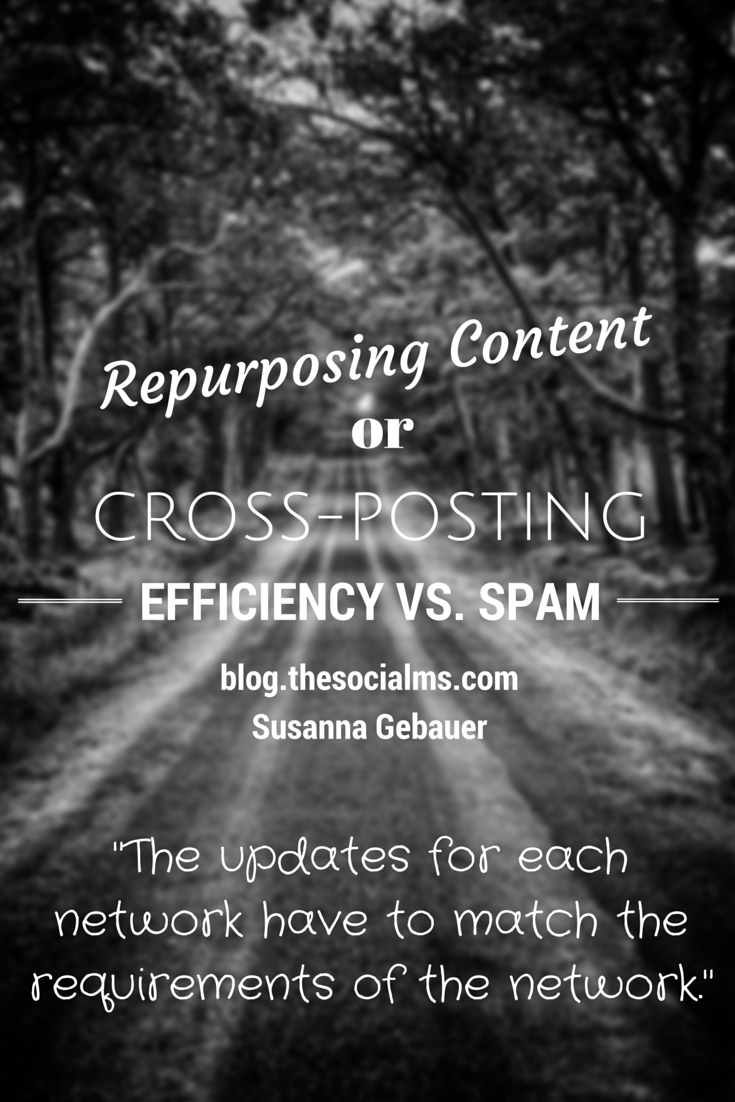I use many networks. I love most of them for unique reasons. And I get totally turned off if I see tons of Pins on Twitter, Tweets on Facebook or get notified on Facebook that someone checked into his bathroom on Foursquare (Swarm).
On the other hand, it is a legitimate way of getting more results from your content creation efforts. Share the same piece of content on different networks.
But you have to keep in mind how each of these networks works and what the requirements for graphics, texts and formats are. The updates for each network have to match the requirements of the network. If you do not want to spend the extra effort on your posts: Don’t spam these networks, you won’t get the results you want anyway.
Repurposing content is more than just reposting content
While repurposing content should be part of any content marketing strategy, each network has its own manners and tolerated behavior. Each network also has its own ideal post formats and text limits. What is easily acceptable in one network might simply be spam in another. If I can see at first glance, that the post originated somewhere else and was automatically spammed to another place, I will definitely not engage in any way or share your post. If you tweet, I will not respond to your tweet on Facebook – why should I?
Before you read on - we have various resources that show you exactly how to use social networks to gain massive traffic and leads. For instance, check out the following:
FREE Step-by-Step Twitter Marketing GuideFREE Pinterest Marketing Ebook
Facebook seems to be the most common victim of ill-done cross-posting. Facebooks algorithm usually prevents these from showing up at all – yet, sometimes it fails and my feed is cluttered with pins, tweets and the likes… . I unfollowed several of my Facebook-Friends – they spammed me with unwanted stuff from other networks. At times like this I am really grateful for Facebook’s Feed-Algorithm and the options to block out unwanted information.
But the problem is not limited to Facebook. I have seen it in other networks, too: Only yesterday I saw a Twitter-account with a long list of shared Pinterest-Links. They do not even show up as pictures. Do you really expect someone to click on them?
With the huge amount of updates we all get on each network, we need to filter out the unwanted and uninteresting stuff. Otherwise the “social” part of the networking will get lost. Instead of getting information and having conversations it feels like being shouted at. No matter if we are listening or not. And most people will close the door to block out the shouting. Was that your intention?
Posting content that is not optimized for exactly the network you share it on, in most cases will not get you anywhere. In many cases, it will simply annoy your audience.
Are you looking for free social media traffic that you can get by following simple and straightforward processes?
We will teach you how to grow your social media audience by providing value. Learn the step- by- step process many marketing professionals use in our ebook “The Social Traffic Code!”
You have more to lose than to gain
If you simply automatically crosspost from one network to another, you will not gain much. Apart from a stray click on Facebook you will get less views on badly optimized updates. An uninteresting tweet-text will get lost in the mass of updates on Twitter. And a pin without meaning will neither attract views nor clicks or shares on Pinterest. Getting results out of bad content is getting harder by the day on any social network. And … anyone who has ever tried to rebuild visibility for a badly run Facebook account can tell you how hard it is to gain back reputation and visibility once you destroyed it with uninteresting content or unoptimized posts.
Hey, before you read on - we have in various FREE in-depth guides on similar topics that you can download. For this post, check out:
FREE workbook: CREATE AWESOME BLOG POSTSFREE Beginner's Guide: START A BLOG
Repurposing content is a totally different case.
This does not mean, that you should not use different social networks to spread your content. Repurposing content will give your content the extra attention it deserves and help you build your following and your reputation in social media. Repurposing content worth the effort, but you need to do it right: Spend time on optimizing your content for each and every network you want to use.
We do use repurposing content: It is actually how we grew the readership of this still very young blog in such a short time: By sharing our blog posts on the social networks where we already built a reputation and a following.
Repurposing Content – How to get it right
If you have written a blog post or created another piece of great content it should be part of your routine to optimize this content for sharing on your favorite networks:
- Make a picture or infographic for Pinterest (optimal size is higher than broad)
- Add a little description and two or three hashtags
- Check if your title makes sense as a tweet (give enough information, keep length below 120 characters including link) – or compose Tweets. Some very successful bloggers create a list of several tweets for each blog post they publish.
- Create a picture for Facebook (optimal size is essential to get more views) – and make sure the right picture is selected when its shared on Facebook (can be tricky)
- Add informative teaser text and consider a call to action as a question. Sometimes you need different teasers for different networks.
- Etc.
With some great tools that allow everyone to easily create pictures and graphics, I like Canva; there is no excuse to post content without optimized pictures. Canva also gives you the optimal sizes for graphics for the different networks.
The difference between repurposing content and automated spamming of badly optimized content to some additional outlets is often underestimated. While repurposing content promises additional attention, and exposure for your content, spam can backfire and very quickly destroy your reputation. It usually leads to people unfollowing you – or not following you in the first place.
It is worth the additional effort to optimize your content for sharing in your major networks. Simply consider how much time and effort you put into creating your content. Is it not worth some extra time to get your content in front of an additional audience?



